20 years ago, I did a solo trip to Nepal with little more than a roundtrip ticket and a Lonely Planet guidebook. I didn’t know where I was going. I didn’t even have any hotels booked. I figured I’d sort everything out when I got there and that’s exactly what I did.
I wound up going white water rafting, sleeping by the river, going on safari, getting high on a week-long trek, and seeing Mt. Everest up close from an 18-seat turboprop plane. The trip that came out of that leap of faith is still one of my most memorable. It was my Lewis and Clark moment.
But alas, a lot has changed since then. Much of that youtfhul bravado has been beaten out of me by life, responsibility, and an irrational fear of impending doom. Not that I’m any less curious in my middle-aged years. I am. I just don’t dive in head first as much as I used to. I’m more deliberate now. I do research and I plan. Obsessively.
Yes, I may not be as bold and impulsive as I used to be, but at least I can come up with a better itinerary. Here’s how I do it.
GUIDE TABLE OF CONTENTS
WHEN TO GO / HOW MANY DAYS TO STAY
This is one of the first things I search for when planning a trip. If you look through my browser’s history, you’ll find many entries for “how many days to stay {destination}” and “best time to go {destination}”. With so much of the world to see, I approach every new destination as our first and last, so I want to make sure we stay long enough to make it count.
When deciding on when to go, I steer clear from peak seasons because it’s the priciest and most crowded. If our chosen destination is subject to extreme weather conditions like typhoons or harsh winters, then I’ll avoid those months as well despite the lower prices. Instead, I aim for shoulder seasons — those times of the year when the weather is decent but off peak so we get the best of both worlds. “annual weather {destination}” is a good search term to help you figure this out. For our upcoming trip to Turkey, that ideal time turned out to be in October-November.
Getting to know your destination’s climate is a must when travel planning.
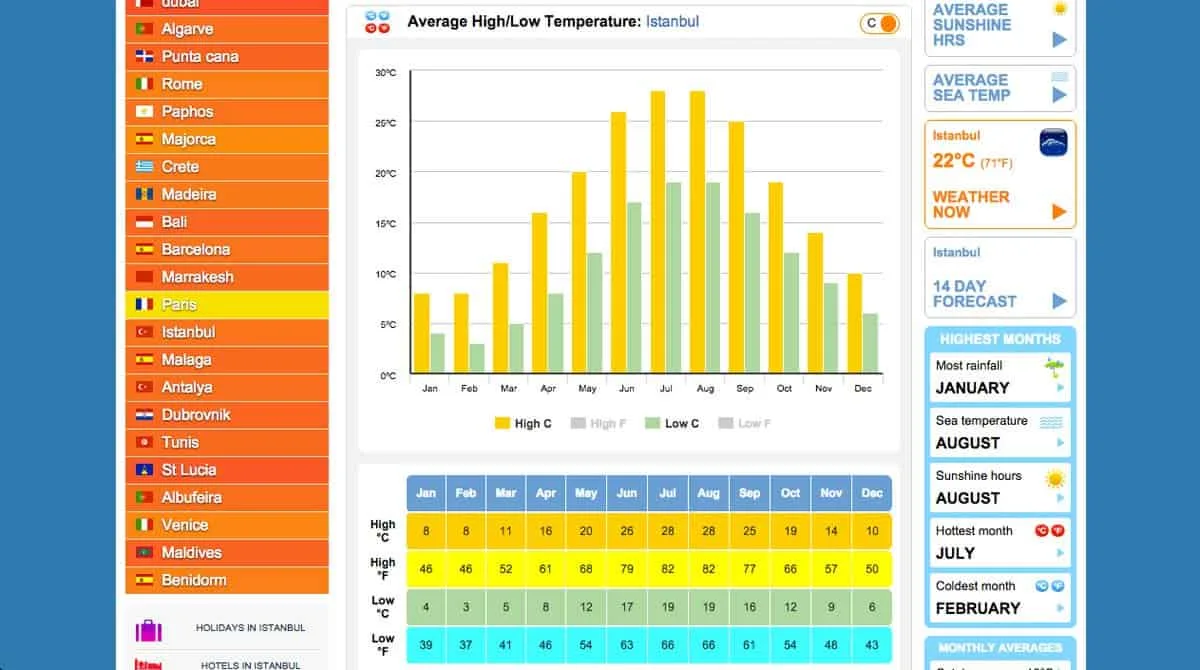
When deciding on how long to stay, it’s easier when you’re going to a single city destination like Seoul. But for a multi-city trip like Turkey, you’ll have to google “how many days to stay {destination}” for each of the cities you’ll be visiting as well as factor in travel times between destinations. I like to fill up our days with activities without rushing too much, so I tend to go for the long end of what people suggest. If most people say 3-4 days, then I’ll go for 4. With 5 places to visit in Turkey including 2 domestic flights, a train, an all day guided tour, and an overnight bus, that amounted to 14 days for us.
By the way, when you google the search terms above, you’re likely to get plenty of results. I’ll read all within the first 3-4 pages of results, though I tend to give more weight to trusted websites like TripAdvisor. Whether to research hotels, attractions, restaurants, currency or transportation information, it’s hands down the BEST website for travel planning. I use it for all our trips.
HOW TO FIND CHEAP AIRLINE TICKETS
Once you’ve figured out when to go and how long to stay, it’s time to hunt for cheap airline tickets. The first thing you should do is follow airline accounts on social media like Facebook and Twitter. Because promo tickets go fast, it’s important to check off “Get notifications” on Facebook as well. That way you’ll get instant alerts every time they post something new. Many of those will be fluffy memes about aircraft fuselage and how to say “I love you” in Swahili, but you’ll be first to hear about the really good stuff too, like half off or more deals on airfare. Case in point, I scored PHP 815 round trip tickets to Bohol (regular PHP 4,800) next year thanks to these alerts.
If you need to fly out within a specific time frame and can’t wait for special promo tickets, then you can try searching for cheap airfare on flight booking websites like JetRadar or Skyscanner. These are travel search websites that help you find the cheapest flights from a number of carriers and travel agencies. Right now, I have 5 bookmarked — Skyscanner, JetRadar, Google Flights, Kayak, and ITA Software — with the first 2 getting the most mileage. Using JetRadar, I was able to book roundtrip tickets to Istanbul from Manila on Etihad for less than USD 770 each, a significant price reduction from the regular fare of USD 1,000+.
Among the flight booking websites I use, JetRadar consistently seems to find the best deals.
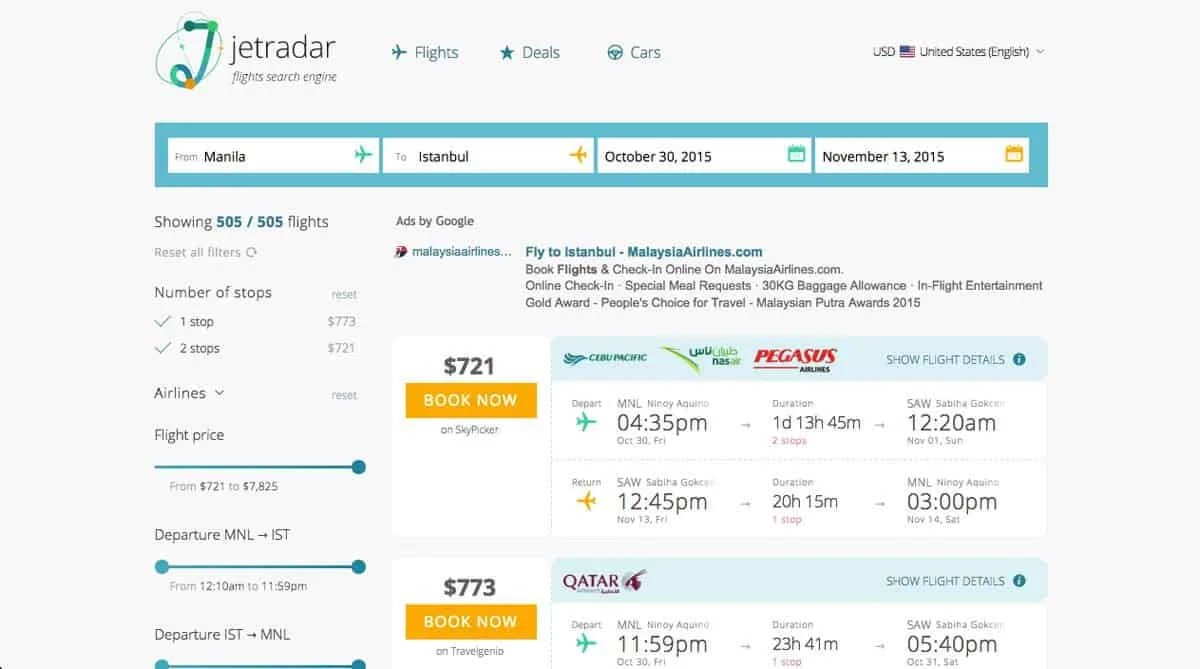
But before you go crazy snapping up airfare deals, there’s one thing you’ll need to understand about these flight booking websites. They’re basically just travel search engines that find you available flights. You don’t buy tickets directly from them. Instead, they’ll forward you to the airline or travel agency website where you can actually buy the tickets.
Many people have qualms about buying airline tickets from little known travel agencies fearing it might be a scam. I’m sure many of these agencies are legitimate, but it’s always safer to buy directly from the airline’s website. If you find a good deal on a third party website, I suggest searching for the same deal on the actual airline’s website just to see if it’s being sold there as well. Chances are you’ll find it, albeit at a higher price. If the price difference isn’t significant, then I suggest buying directly from the airline.
With that said, I do understand that travel agencies often get exclusive deals from airlines that you won’t find anywhere else. Just because you don’t find it on the actual airline’s website doesn’t mean it’s a scam. You just need to exercise caution and use your better judgement. As they say, if it sounds too good to be true, then it probably is. Proceed at your own risk.
Based on what I’ve read online, many of these budget tickets sold by travel agencies are legit, but you’ll have a rough time trying to change dates or get any kind of customer service. If you aren’t dead set on your travel plans and need some wiggle room, then you’re better off booking directly with the airline.
WHERE TO STAY / HOW TO FIND A HOTEL
Now that you’ve booked your flight, it’s time to figure out where to stay. There are many hotel booking websites out there, but these are the ones I use — Booking.com, Agoda, and TripAdvisor.
I’ll start by googling phrases like “where to stay {destination}” and “best area to stay {destination}”. If you’re going to a popular enough place, then you’ll find lots of good information from various sources. Some of the best and most reliable come from TripAdvisor forum users sharing their past experiences. Those forums are very helpful and will lead you to areas that are accessible, safe, and close to major commercial areas. For our Turkey trip, that ideal neighborhood turned out to be Sultanahmet or Fatih.
Once I’ve picked out a neighborhood, I’ll go to Booking.com or Agoda and type in the dates and name of the area. From there I’ll filter the results based on ratings and pick out hotels that fit our budget. Ren and I are middle of the road travelers so we always go for hotels that provide a good balance between comfort and value. Once I have my list, I’ll start reading user reviews and scratch off any hotels that have too many negatives or too few reviews. If the hotel is a TripAdvisor Certificate of Excellence awardee, then it gets major bonus points. I prefer Booking.com and Agoda because they allow me to cancel up to a few days before our arrival date without penalties.
See that green bar in the first listing? That means you can book now and pay later.
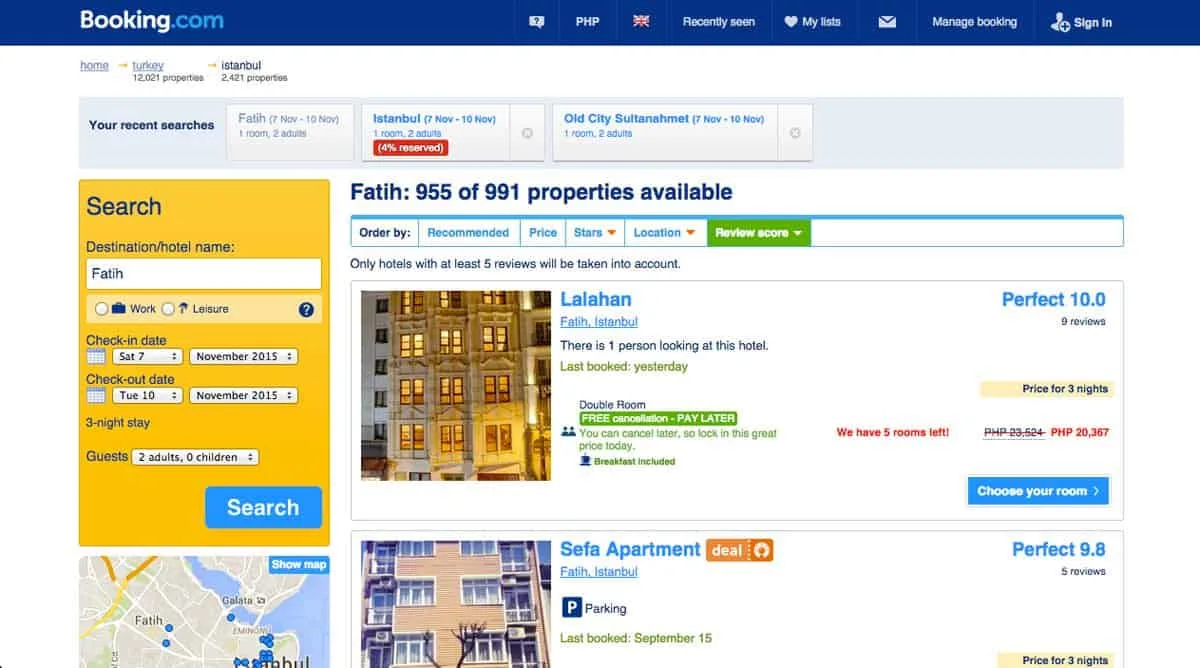
WHICH SITES TO VISIT / WHAT ACTIVITIES TO DO
Once you’ve bought your airline tickets and made hotel reservations, it’s time to start planning your itinerary. I start by doing a search for “where to go {destination}”, “what to do {destination}”, and “best places to visit {destination}”. A destination only has so many major tourist attractions so most lists will include the same places and activities. I’ll go through every post within the first 3-4 pages of search results and list down what we like in a Word doc. When I have enough, I’ll google “best places to visit tripadvisor {destination}” and start narrowing down my list.
Top Istanbul attractions based on TripAdvisor user reviews.
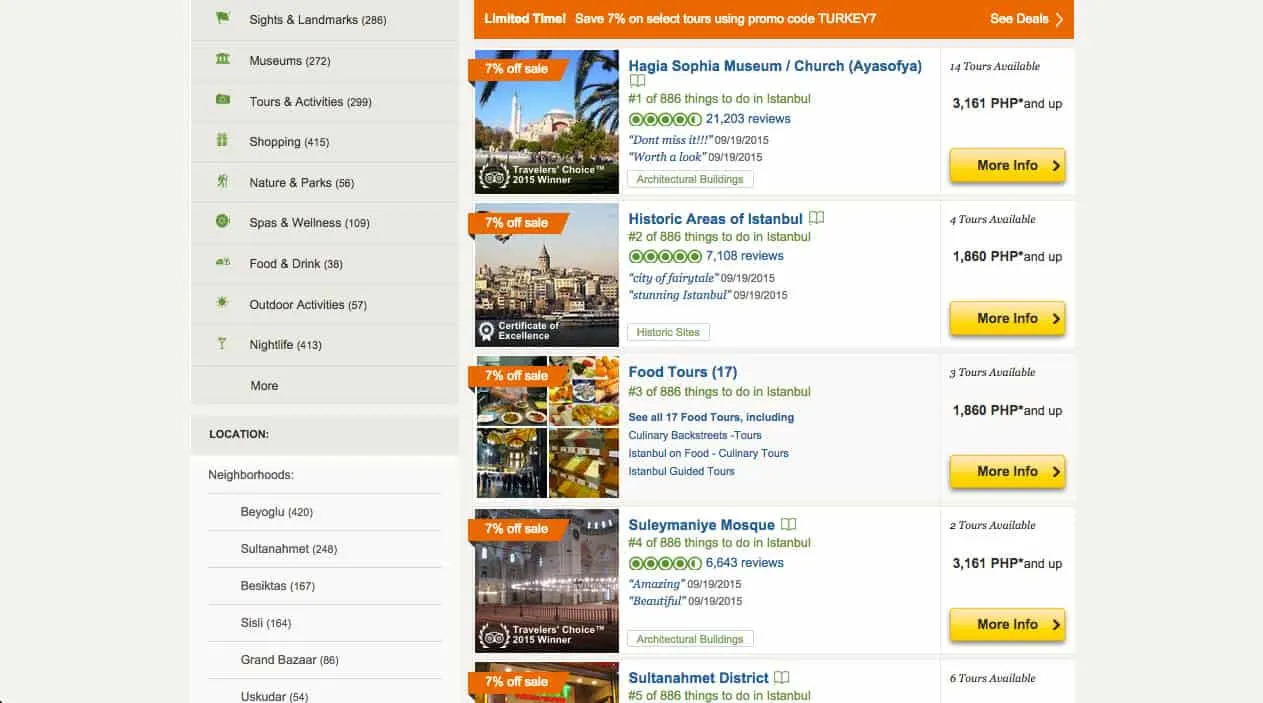
What I love about TripAdvisor is that it lists the top attractions based on user ratings. With such a large database of travelers, you often have thousands of reviews to help you makes your choices. If an attraction lands on the first page of TripAdvisor and is a Certificate of Excellence or Travelers’ Choice awardee, then it’s pretty much guaranteed a spot on our itinerary.
Once I have a big enough list, I’ll google “how much time to spend {attraction}” for each attraction and make a note of it along with any entrance fees in my Word doc. I’ll explain how I decide on which day and in what sequence to visit the sites in the HOW TO ORGANIZE YOUR ITINERARY section of this post.
WHAT FOODS TO TRY / WHICH RESTAURANTS TO DINE AT
The process for figuring out where to eat is similar to choosing which places to visit, except this can be more challenging with so many more restaurants to choose from. I start by googling “where to eat {destination}” and “must try restaurants {destination}”. With food being subjective and restaurants plentiful, the articles you’ll find will be more diverse than the ones on tourist attractions. If I see the same restaurant mentioned on more than one article, than I’m pretty sure it’s good. We like to eat local food when traveling as well, so I automatically eliminate any sushi bars in Cairo or Ethiopian restaurants in Oslo.
Another search term that helps me narrow my list is “what to eat {destination}”. This doesn’t bring up any restaurants per se, but specific dishes and street foods. For Turkey, some of those dishes include lahmacun, kebap, and balik ekmek. I’ll then google “best place lahmacun istanbul” and hopefully come up with a few suggestions.
Once I have a big enough list, I’ll google “where to eat {destination} tripadvisor” so I can start reading user reviews. I’ll then finalize my list based on price, user reviews, and TripAdvisor Certificate of Excellence awards. I’ll jot them all down in my Word doc together with specialties, addresses, and prices so I can organize them further. More on that in the HOW TO ORGANIZE YOUR ITINERARY section of this post.
It’s amazing how I can find almost anything on TripAdvisor. I read about an obscure-sounding restaurant on a blog post and boom, there it is.
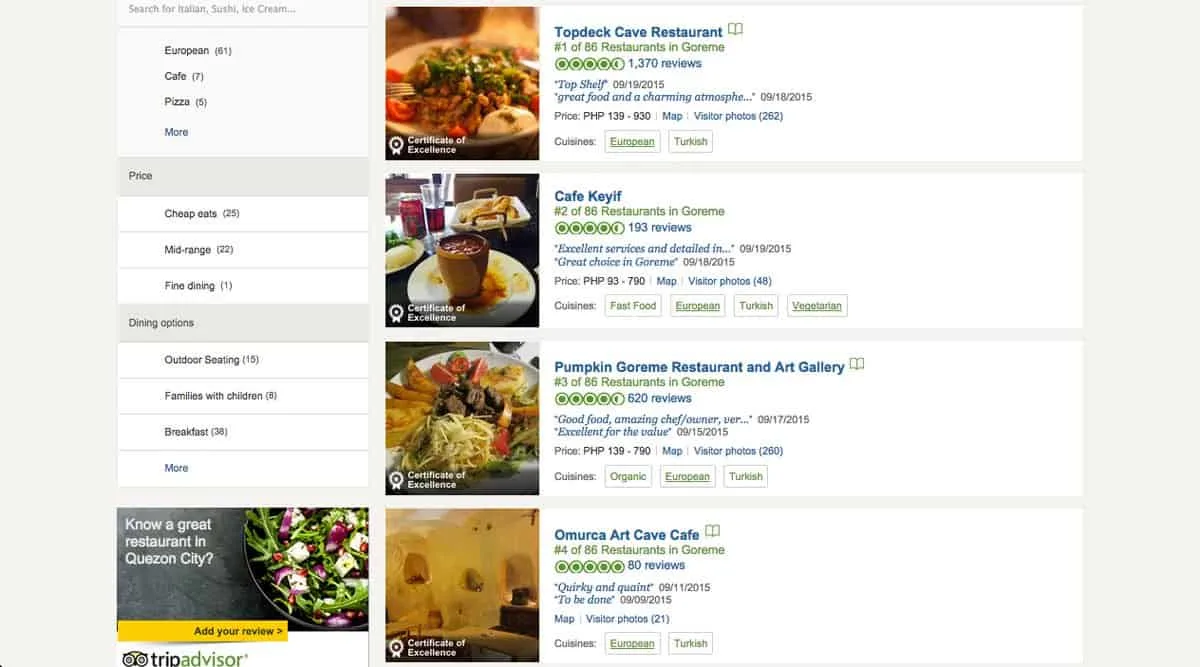
HOW MUCH MONEY TO BRING
Now that you know where you’re staying, going, and eating, it makes it a whole lot easier to figure out how much money to bring. Here’s a snippet of our itinerary to Turkey:
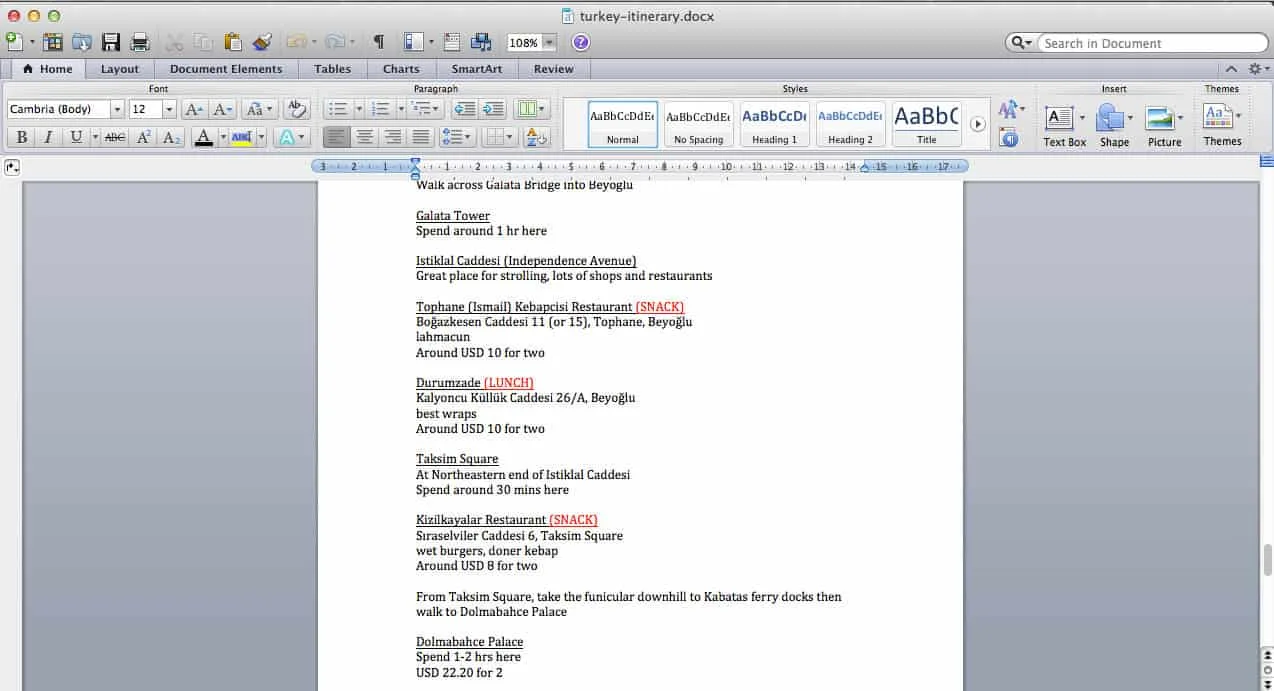
To help me determine how much money we’ll need, I list down all the unpaid expenses I can think of like hotel rates, entrance and activity fees, approximate meal costs, transportation fare (more on this later), and shopping money. When I have a rough total, I’ll figure out how much of it I’ll be paying for in exchanged currency, credit card, and ATM cash withdrawals.
I usually prefer to pay for our hotels using a credit card and all else with exchanged currency, but Turkey is a different animal. Many places accept payments in TL (Turkish Lira), USD, and Euro, but you get a better price for most everything when you pay in TL. For that reason, I’ll be paying for things mostly with TL withdrawn from ATMs and bringing a safe amount of USD and credit cards as backup.
It’s very important that you familiarize yourself with your destination’s currency before going. Should you exchange currency at home or exchange it at your destination country? The answer varies from country to country and currency to currency so be sure to do your research beforehand. Again, some of the best information will come from TripAdvisor forums.
If you choose to bring foreign currency, then googling phrases like “what foreign currency to bring {destination}” and “where to exchange currency {destination}” are a must. As a rule, airports give terrible exchange rates but you’ll often need to change a small amount there until you can reach a bank or money changer. Keep in mind that hotels usually don’t give the best rates either.
If you plan on using your ATM or credit cards abroad, then be sure to inform your bank and credit card company of your travel plans before going. Otherwise, they may not work.
HOW TO ORGANIZE YOUR ITINERARY
Now that you have a comprehensive list of attractions and restaurants to visit, how do you put them all together? That’s a daunting task made easy with Sygic Travel (formerly Tripomatic). Discovering this app made itinerary planning a breeze.
With this free app that you can use on your desktop and mobile devices, you can plot points of interest on a map, including your hotel, so you can see exactly how far you need to travel between points. This enabled me to lump places that were in close proximity to each other in an effort to minimize travel time. So all attractions and restaurants that were in one area I planned for one day, and all attractions and restaurants in another area were planned for a different day, and so on and so forth. Awesome right?
Sygic Travel even tells you the distance between attractions. Though popular tourist attractions are in the map by default, most restaurants are not, so you’ll need to know their addresses and create custom places for them on the map. Easy enough. 🙂
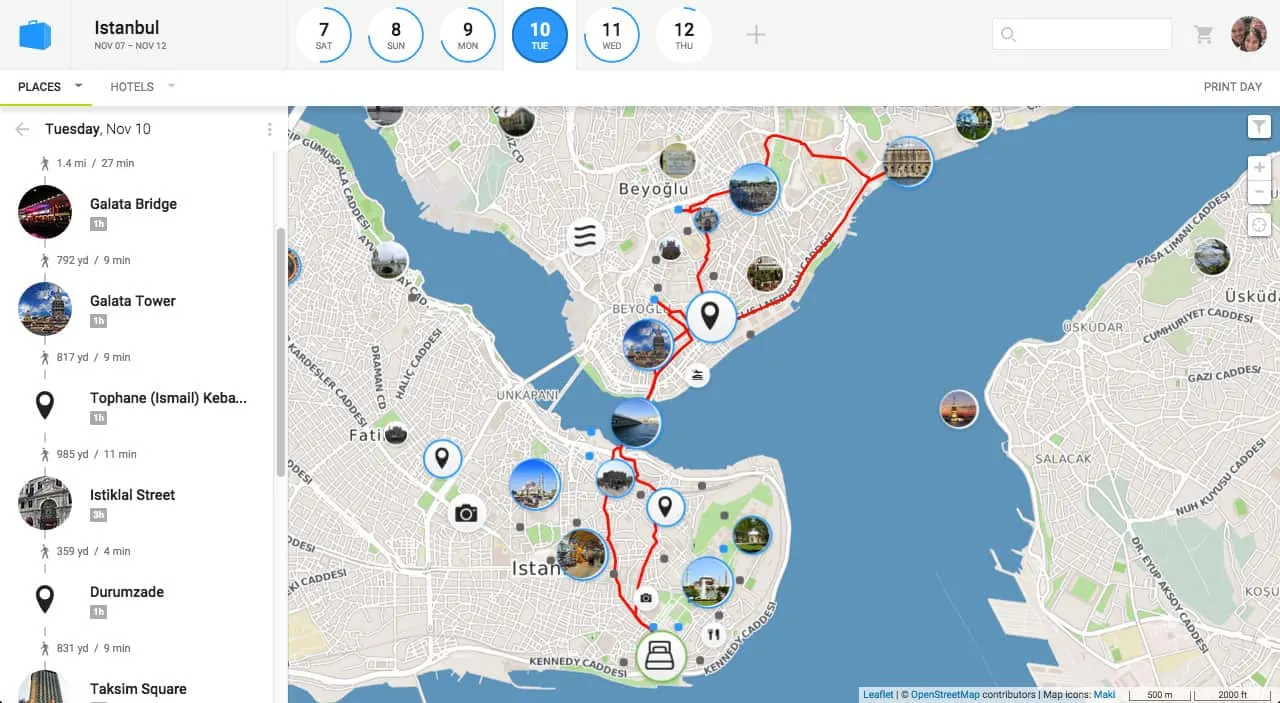
Check out my post on the Sygic Travel app for more information. If you have pocket wifi, you’ll be pleased to learn that Sygic Travel has GPS tracking as well.
OTHER THINGS TO CONSIDER
1. Get your Travel Documents in Order
If you’re a back of the bus Philippine passport holder like me, then chances are you’ll need a tourist visa pretty much everywhere. Be sure to know what travel documents you’ll need before even planning a trip. Googling phrases like “tourist visa {destination} for {nationality}” will tell you that.
2. Figure out the Local Transportation System
Every destination will have a different “best way to get around”. In Langkawi and Davao, it was by rental car. In Seoul and Osaka, it was by subway. In Siem Reap, it was by tuk tuk. Before you go, be sure to google “how to get around {destination}” for information on best ways to travel.
If you’ll be taking mostly public transportation like subway or bus, then you should find out if there are any available discount passes. You can do this by googling phrases like “subway pass {destination}”, “bus pass {destination}”, or “public transportation pass {destination}”. If there are discount passes available, then you should figure out if it’s worth getting one for your trip.
It’s easier to do this if you create day-by-day itineraries as I’ve suggested in previous sections. Because I know which sites we’ll be visiting each day and in what order, I can estimate public transportation costs by referring to a destination’s subway or bus map. In Seoul for example, there was an M-Pass that allowed you 20 rides per day. Based on my estimate however, that was too many and not worth it for our purpose so we went with a T-Money card instead.
It’s important to determine not just how you’ll be getting around, but what discount passes (if any) will be best for your travel needs.
3. Download Useful Apps
Aside from Sygic Travel, these are the other travel apps I use. They’re all free.
XE Currency

XE Currency converts amounts in multiple currencies using live rates. It stores the last updated rates so can even work offline. This should be on every traveler’s mobile device.
Trail Wallet
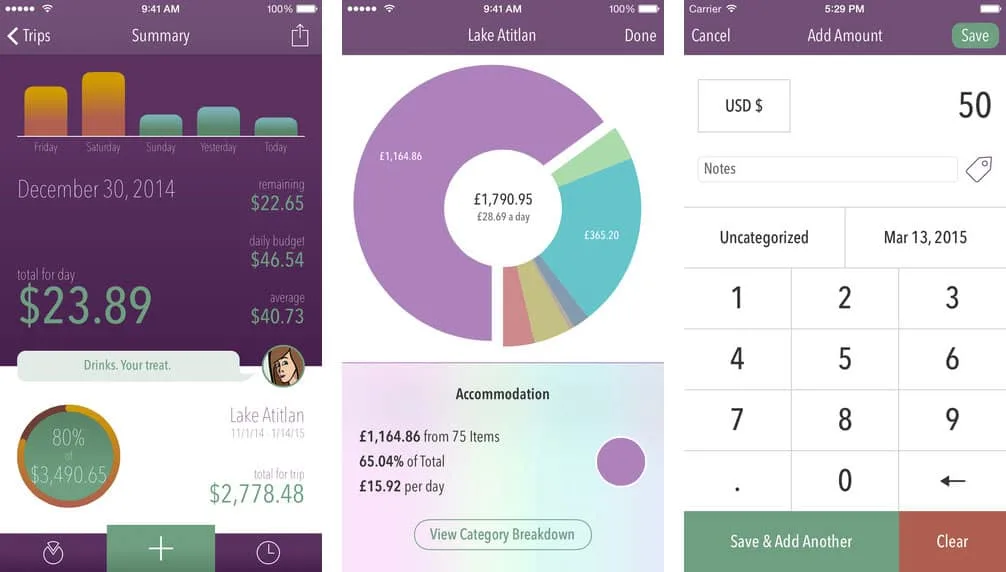
I used to manually add up expenses using “Notes” on my mobile phone until I recently discovered this app. You can organize your expenses by trip or by month, set yourself a daily budget, then easily add expenses as you go. No more manually adding amounts up in my head! I’ll be using it for the first time in Turkey.
4. Get Pocket Wifi
Many public spaces have free wifi these days, but if you’re a wannabe-millenial like me who likes telling people what he’s eating on Instagram, then you’ll need a constant wifi connection. Google “pocket wifi rental {destination}” and arrange for one before your trip. They’re usually delivered to your destination hotel a day before you arrive together with a self-addressed stamped envelope. Before leaving the country, you can put the device in the envelope and leave it at your hotel’s front desk or drop it in any postal box. There’s usually one at the airport. I order a pocket wifi device now every time we travel.
5. Prepare for the Language Barrier (if any)
You’ll find many articles when googling “useful phrases {destination’s language}”. These are great for learning basic phrases like “thank you” or “excuse me”, but they’ll be of little help when you’re trying to get somewhere. In the event that we get lost and can’t find a place, I print out the names and addresses of every attraction and restaurant on our itinerary in the local language. That way I can easily show it to a local without having to struggle with its pronunciation. This is particularly helpful when trying to locate obscure restaurants.
6. Learn Basic Customs / Etiquette
Some destinations like Japan have more rules of etiquette that you should familiarize yourself with, things like slurping ramen loudly and exchanging payments using a tray. But regardless of where you’re going, every place will have basic customs and practices that you’ll need to know.
Like tipping. In some countries it’s expected, while in others it’s an insult. In Turkey for example, I learned that it’s customary to give around 5-10% at restaurants. Hotel staff expect 5-20 liras depending on their duties, while taxi drivers aren’t tipped though cab fares are usually rounded up. These things you need to know, lest you annoy the locals for even breathing their air. Googling phrases like “customs etiquette {destination}”, “tipping {destination}”, or “what to wear temple {destination}” should keep you from getting cussed out for being a stupid gaijin.
7. Get Travel Insurance
To be honest, it was only recently when we started buying travel insurance. Back when we traveled just once or twice a year, travel insurance felt like an added expense, something we could do without. But now that we travel more, I understand how important it is to have it. Fact is, you never know what can happen on the road. It’s one of those things that you hope you never have to use, but if you do wind up needing it, then you’ll be thanking the gods that you had it (or cursing them if you didn’t).
Though I do find it more necessary now, it’s still up to you if you think you need it. A 3-day trip to Singapore just shopping and eating may not really call for insurance but if you plan on doing more active things like skiing, snowmobile riding, or even going on a bike ride, then I’d say travel insurance is a must.
When we feel the need for insurance, we buy it from SafetyWing. They’re a popular travel insurance provider used by many digital nomads. Click on the link to get a free quote from SafetyWing.
PLAN WELL, BUT ALLOW FOR SURPRISES
I may not be as carefree as I used to be, but I still do welcome spontaneity. As wise as it is to plan thoroughly, I think it’s equally important to leave room for the unexpected in your trips. Things like reserving a day for unplanned exploration, or randomly picking the last stop on a subway map and spending an afternoon there. Sometimes, the most memorable experiences are born from unexpected circumstances. That image of Mt. Everest, though 20 years old, still comes to mind for me.
In parting, now that you know HOW to plan your trip, learn WHY you should plan a trip from this in-depth article on the science-backed benefits of travel. Enjoy your trip! 🙂
Disclosure
Some of the links in this guide are affiliate links, meaning we’ll get a small commission if you make a purchase at NO extra cost to you. We only recommend products and services that we use ourselves and firmly believe in. We really appreciate your support as this helps us make more of these free travel guides. Thank you!

Laviolas
Wednesday 23rd of May 2018
Please change the title of the article. It does come across as quite insensitive to people suffering from OCD.
JB & Renée
Wednesday 23rd of May 2018
I have OCD Laviolas and I see nothing wrong with it. You don't have to be offended by everything. :roll:
BouncingMonkey
Friday 28th of October 2016
Hey, awesome tips, thanks a lot! My question is, what is the website you used for climate on your picture? Seems cool, but couldn't find the exact one on the web. Best!
JB & Renée
Friday 28th of October 2016
Hey BouncingMonkey, that screenshot is from www.holiday-weather.com. :)
Mack Jordan
Friday 6th of May 2016
Its helping me so much, we are having our family vacations the next 2 weeks.
Rebecca
Friday 6th of May 2016
You are fantastic! These tips are helping us plan out our escapade. Nice job!
Charm Gawaran
Friday 29th of January 2016
Your travel blog is super helpful with people with self-proclaimed OCD like me. lol First time I saw your blog was when we were searching for infos regarding Sagada, i love the fact that it was so detailed. Since then, I always make sure to visit your site every time I make the itinerary for our next travel. Your suggested apps (especially the tripomatic) are very helpful in organizing our trip. Right now, I'm reading your Japan blogs and I'm so happy to read your experiences there..
So grateful for people like you to be kind enough to share tips and information to other people. Continue to inspire others. God bless you always Sir! :)
JB & Renée
Friday 29th of January 2016
Awww thanks Charm! It's my pleasure. Isn't Tripomatic awesome? I have a poor sense of direction so it was always difficult for me to locate a place when traveling. Tripomatic makes it a breeze. Happy travels! :)